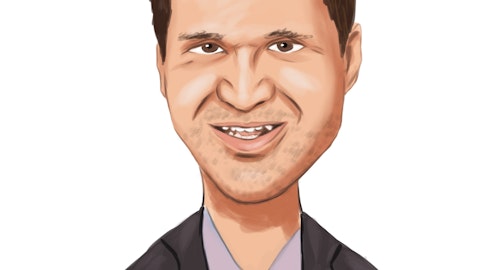Phil Eyler: Clearly, the BPS, you called out the right number at the midpoint was $150 million growth of BPS. We’re actually going to see a decline of BPS, so not just a loss of the growth, but actually a decline from now until that time period. So that’s going to be the biggest driver of the reduction. And then, as you pointed out, we expect to see a delayed ramp up of some of the EVs that we are targeted on just based on feedback from our customers and what we’re seeing in the market expectations. The second, the next factor is related to North America vehicle production in 2026. We’re actually seeing a decline in a few of our large North America OEMs outlook for 2026 based on the S&P global outlook, which kind of makes sense to us. So that’s going to be a factor as well.
Operator: Our next question comes from the line of Glenn Chin with Seaport Research Partners.
Glenn Chin: Congrats on all the wins and the win rate. Just sort of following on Matt’s line of questioning. There’s been a lot of delays, deferrals in EV launches, production, et cetera. I assume that’s already reflected in – there’s nothing further to be reflected in the awards that you just booked, the $900 million in this quarter. But is it possible to dimension, Phil, what sort of revisions might have to be made to prior bookings, notwithstanding the fact that you’re talking about it for 2026? But any ways you can dimension for us, for example, what percent was EV related perhaps?
Phil Eyler: It’s tough for us to break down the percent EV in the awards because some of the awards – in fact, many of the awards are cross platform. Just to give an example, the BMW X series wins that I called out is on both the ICE and the EV. So that’s more of a combined number. But I would say, to the best of our ability, we built that into our plan for 2024 and then 2026 as well. We clearly still believe in EVs as a driver for future growth. As that becomes more clear in those out years beyond 2026, obviously, we’ll start to build that into our outlook.
Glenn Chin: Just follow-up on the GM architecture question. Can you give us a sense of the timing there? When do these launch?
Phil Eyler: They will take a couple years before that new architecture goes in.
Operator: Our next question comes from the line of Ryan Sigdahl with Craig-Hallum. Capital Group.
Ryan Sigdahl: Just staying on GM and ClimateSense, is that award or the architecture for ClimateSense, is that included in the Q4 awards? And then also, is any of that included in the 2026 targets, given it’ll take a couple of years?
Phil Eyler: Yes, it’s included in both.
Ryan Sigdahl: On content, you historically have talked about 2x to 4x higher content for ClimateSense. Is that a good rule of thumb for this award?
Phil Eyler: I think it scales. Given the fact that the software will orchestrate any level of climate seating and steering wheel, it could span all the way from, let’s call it, an entry vehicle that has low content all the way up to the higher content, so we’ll have to see how that plays out across their portfolio over time. But we definitely are seeing a movement for tire content, as we have ClimateSense control in a car.
Ryan Sigdahl: On the BPS cell connecting product, you guys launched a very large award with BMW just a few quarters ago there. I guess is the assumption that that sunsets after this platform?
Phil Eyler: Yes, it is.
Operator: [Operator Instructions]. Our next question comes from line of Ryan Brinkman with J.P. Morgan.
Ryan Brinkman: Just another one on the recent win with GM. Understand your share of GM seat comfort business will rise, but is there something about this award that also makes you think that maybe the penetration of seat comfort products within GM could materially increase, either because the vehicles – it’s offered in more vehicles, more trim levels or maybe because it’s designed right into electrical architecture? Or maybe because the synergies and economies of scale that both you and GM might realize by compromising and expanding the offering could afford a lower price point to GM or hopefully the consumer helping to drive the penetration? Just trying to understand if this is more about increasing your share versus competitors of these products or maybe about driving the penetration of the products? Which would you say is that the bigger opportunity?
Phil Eyler: I think there’s probably some of all those points. I think those are very astute points. But I think the biggest thing – to kind of break it down, on EVs, we definitely expect to see a higher penetration rate and content on EVs. And certainly, that could apply to any kind of electrified vehicle, by the way, whether it’s a fully VR or a plug-in hybrid. And mainly because, obviously, you get the comfort benefit, but you also get the range extension, and that remains a clear, important feature for our customers. If you look at the ICEs, we’re really excited that ClimateSense is going to orchestrate climate seating in ICEs. And the reason is very compelling value proposition for consumer comfort because it really becomes seamless.



